Immune responses against pathogens are divided into the innate and adaptive immune response systems. The adaptive immune response, also called the acquired immune system, consists of 2 main mechanisms: the humoral- and cellular-mediated immune responses. Humoral immunity is mediated through B cells (producing antibodies), whereas cell-mediated immunity involves T cells. As the 2nd line of defense, the adaptive immune system is slower and responds over a longer period of time, but the effect generally leads to specific immunological memory. The 2 important characteristics of adaptive response are specificity (with antigen recognition) and memory (immune response mounted with reinfection).
Last updated: Dec 15, 2025
The immune system Immune system The body’s defense mechanism against foreign organisms or substances and deviant native cells. It includes the humoral immune response and the cell-mediated response and consists of a complex of interrelated cellular, molecular, and genetic components. Primary Lymphatic Organs provides defense (immunity) against invading pathogens ranging from viruses Viruses Minute infectious agents whose genomes are composed of DNA or RNA, but not both. They are characterized by a lack of independent metabolism and the inability to replicate outside living host cells. Virology to parasites, and its components are interconnected by blood and the lymphatic circulation Circulation The movement of the blood as it is pumped through the cardiovascular system. ABCDE Assessment.
2 lines of defense Lines of Defense Inflammation (that overlap):
| Innate immunity Innate immunity The capacity of a normal organism to remain unaffected by microorganisms and their toxins. It results from the presence of naturally occurring anti-infective agents, constitutional factors such as body temperature and immediate acting immune cells such as natural killer cells. Innate Immunity: Phagocytes and Antigen Presentation | Adaptive immunity | |
|---|---|---|
| Genetics Genetics Genetics is the study of genes and their functions and behaviors. Basic Terms of Genetics | Germline encoded | Gene Gene A category of nucleic acid sequences that function as units of heredity and which code for the basic instructions for the development, reproduction, and maintenance of organisms. Basic Terms of Genetics rearrangements involved in lymphocyte development |
| Immune response | Nonspecific | Highly specific |
| Timing of response | Immediate (minutes to hours) | Develops over a longer period of time |
| Memory Memory Complex mental function having four distinct phases: (1) memorizing or learning, (2) retention, (3) recall, and (4) recognition. Clinically, it is usually subdivided into immediate, recent, and remote memory. Psychiatric Assessment response | None | With memory Memory Complex mental function having four distinct phases: (1) memorizing or learning, (2) retention, (3) recall, and (4) recognition. Clinically, it is usually subdivided into immediate, recent, and remote memory. Psychiatric Assessment response, which responds quickly upon recognition of antigen Antigen Substances that are recognized by the immune system and induce an immune reaction. Vaccination ( Ag AG Metabolic Acidosis) |
| Recognition of pathogen | Pattern recognition receptors Receptors Receptors are proteins located either on the surface of or within a cell that can bind to signaling molecules known as ligands (e.g., hormones) and cause some type of response within the cell. Receptors (PRRs) such as TLRs recognize pathogen-associated molecular patterns Pathogen-Associated Molecular Patterns Sepsis and Septic Shock ( PAMPs PAMPs Sepsis and Septic Shock) |
|
| Components |
|
|
The adaptive immune response is divided into the humoral- and cell-mediated immune systems.
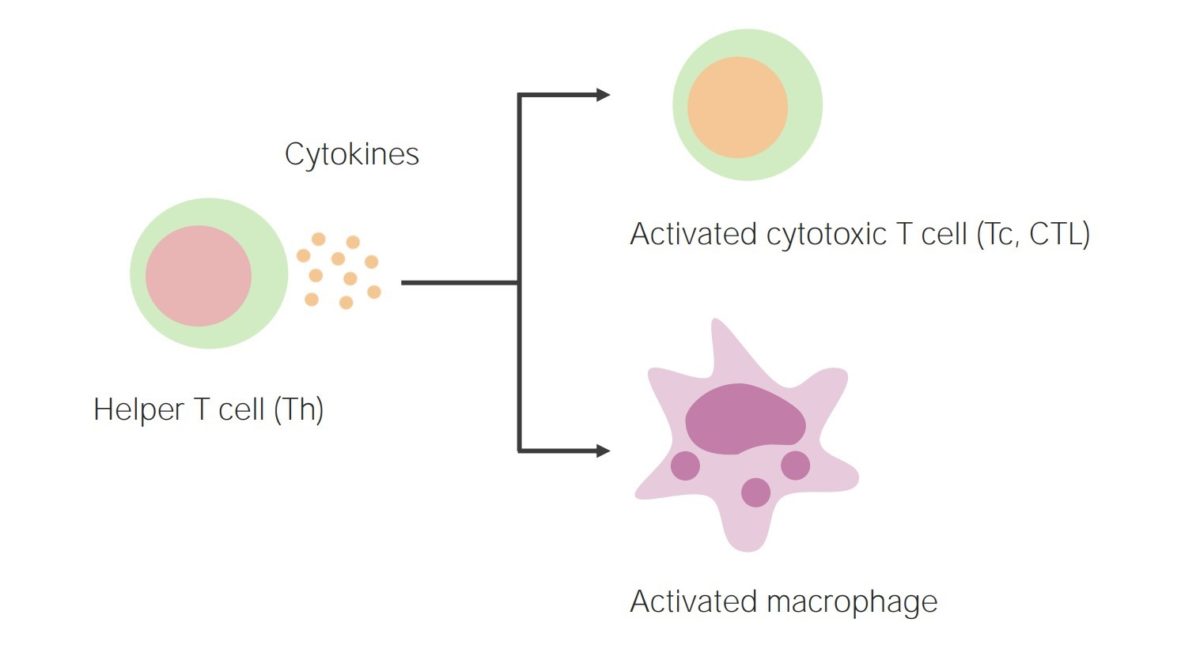
Cell-mediated immunity:
Activation of helper T cells results in the release of cytokines, thereby activating cytotoxic T cells and phagocytes (such as macrophages).
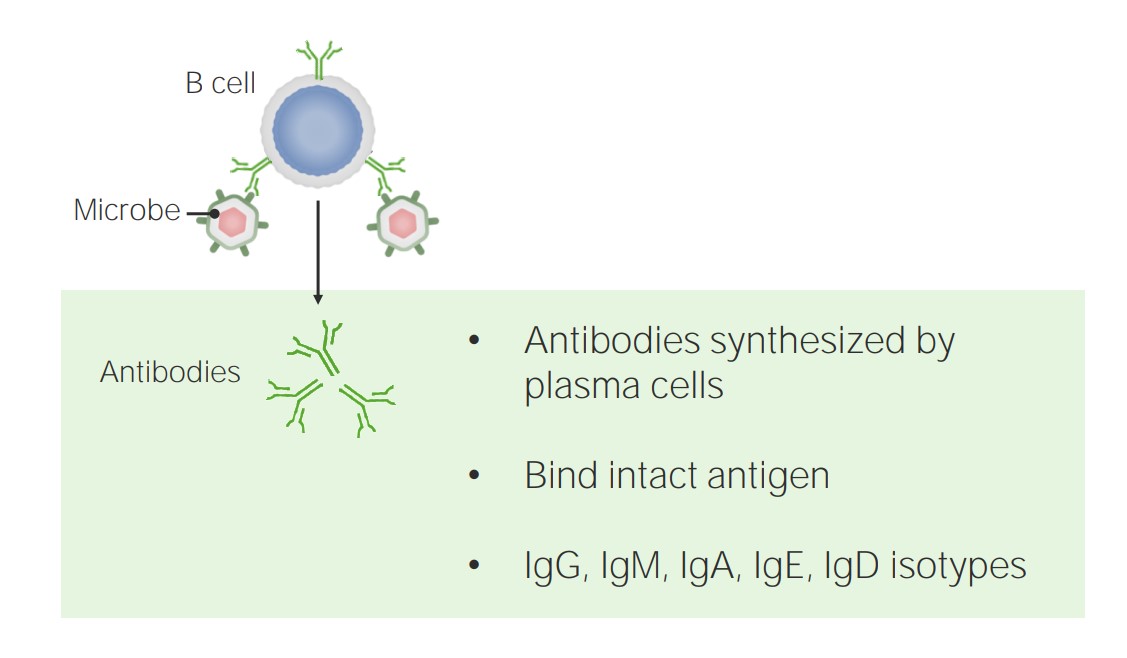
Humoral immunity is mediated by B cells and antibodies.
Image by Lecturio.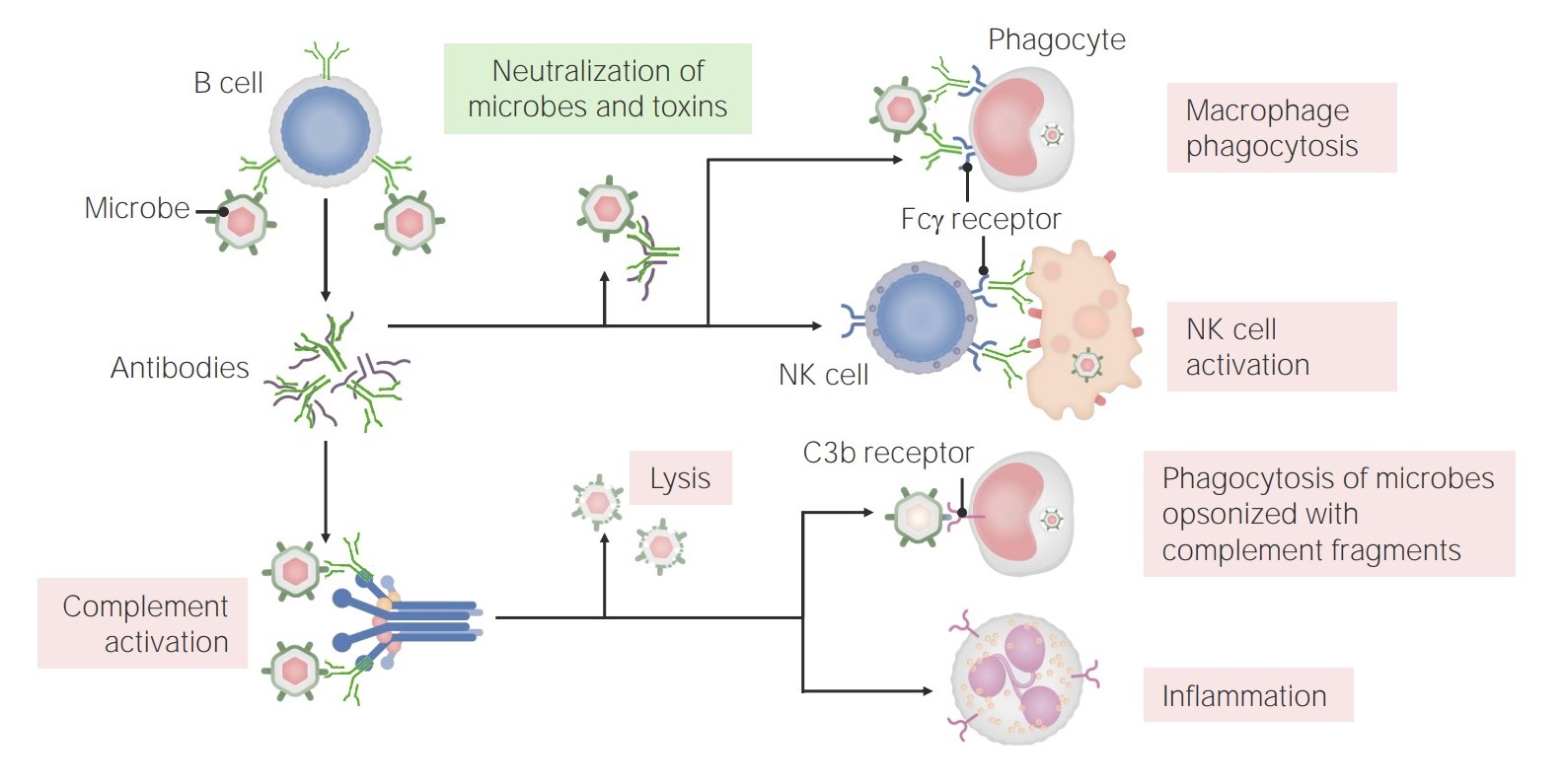
The functions of antibodies:
Antibodies have multiple roles in immunity, including neutralization (of microbes and toxins), promotion of phagocytosis, and NK cell activation. In addition, antibodies have a role in complement activation, which can lead to direct microbe lysis, opsonization and phagocytosis, and recruitment/activation of neutrophils.
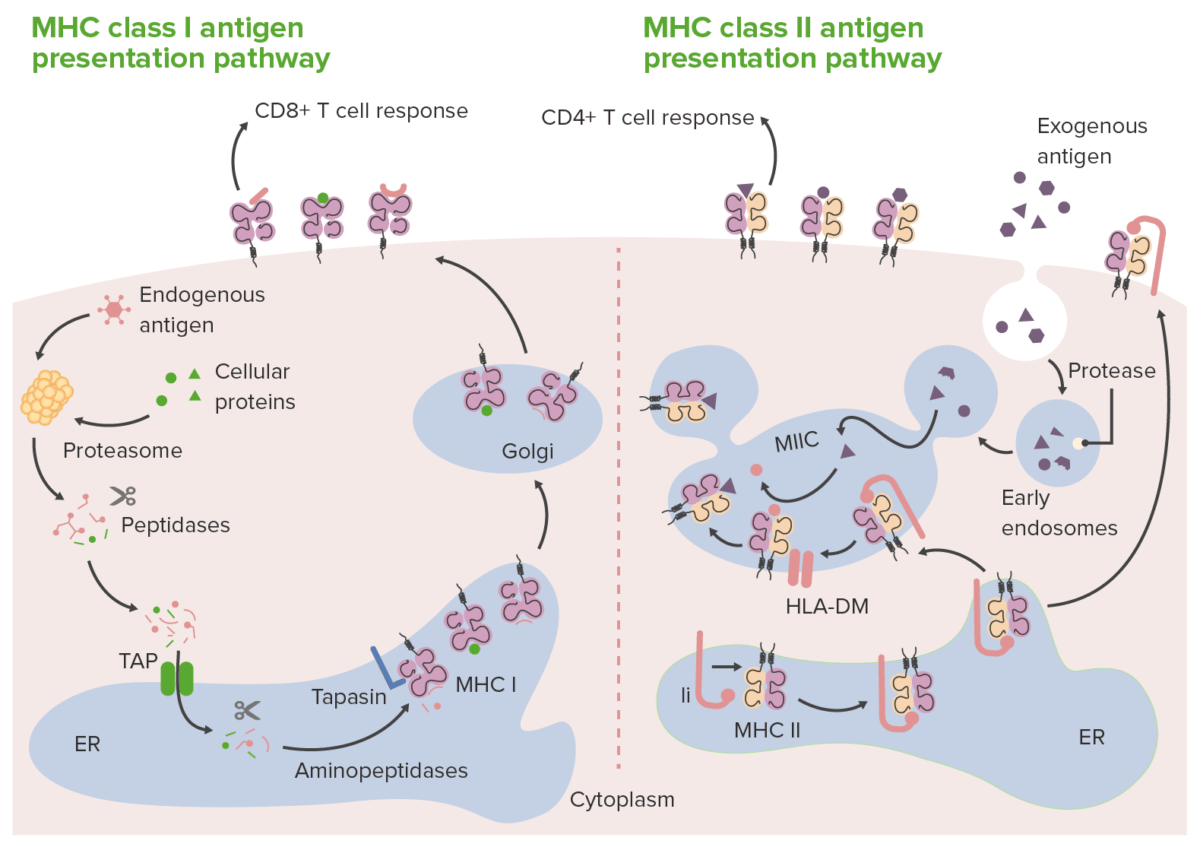
Routes of antigen presentation by MHC class I and II molecules:
In class I Ag presentation (left), proteasomes degrade endogenous Ags or proteins (within the cell) into peptides. Peptide fragments are transported (via transporter associated with antigen processing (TAP)) to the ER, where they are further trimmed by aminopeptidases and loaded onto the MHC class I molecule. The MHC class I–loaded complexes go to the Golgi apparatus for posttranslational modification. Then the complexes are transported to the cell surface, where they are presented to CD8+ T cells. In class II Ag presentation (right), extracellular/exogenous Ags are taken up within phagosomes by Ag-presenting cells. The phagosomes then fuse with proteolytic enzyme-filled lysosomes. This results in the breakdown of phagocytosed proteins into small peptides. Meanwhile, in the ER, new MHC class II molecules are synthesized. These molecules have the invariant chain (pink structure in the right image, marked “Ii”), which binds the Ag-binding cleft. With the cleft occluded (by the invariant chain), ER-resident peptides cannot bind. The invariant chain directs the MHC II complex to the acidified endosome (where Ag peptides are) as it exits from the ER. When MHC II complexes are delivered to the endosome, the invariant chain is released, allowing loading of Ag peptides (chaperoned by a protein, HLA- DM) onto the MHC class II molecules. Once loaded, the formed Ag peptide–MHC class II complexes are brought to the cell surface, ready to present the Ag to CD4+ T cells.
Ii: MHC class II–associated invariant chain
MIIC: MHC class II compartment
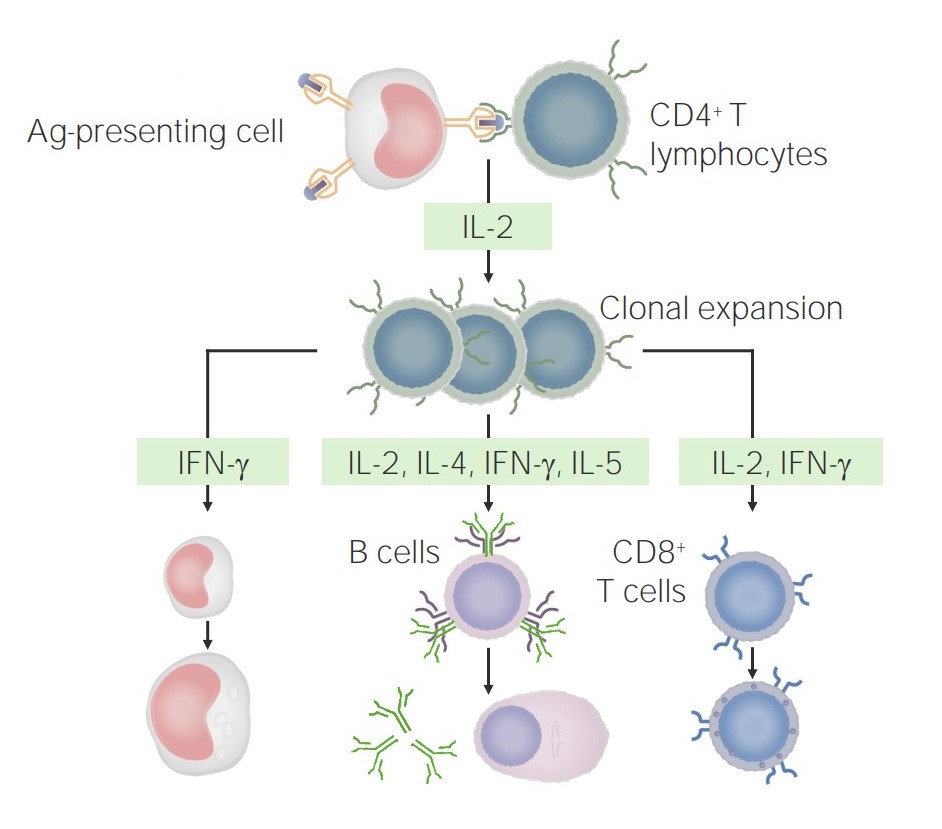
After interacting with Ag-presenting cells, stimulation and clonal expansion of CD4+ T cells occurs:
These cells release cytokines that can have various effects, such as activation of macrophages (left), B cells (middle), and CD8+ T cells.
| CD4+ T cells T cells Lymphocytes responsible for cell-mediated immunity. Two types have been identified – cytotoxic (t-lymphocytes, cytotoxic) and helper T-lymphocytes (t-lymphocytes, helper-inducer). They are formed when lymphocytes circulate through the thymus gland and differentiate to thymocytes. When exposed to an antigen, they divide rapidly and produce large numbers of new T cells sensitized to that antigen. T cells: Types and Functions | Stimulated by | Cytokines produced | Functions | Role in disease |
|---|---|---|---|---|
| Th1 Th1 A subset of helper-inducer T-lymphocytes which synthesize and secrete interleukin-2; interferon-gamma; and interleukin-12. Due to their ability to kill antigen-presenting cells and their lymphokine-mediated effector activity, th1 cells are associated with vigorous delayed-type hypersensitivity reactions. T cells: Types and Functions | IL-12, IFN-γ | IFN-γ, TNF TNF Tumor necrosis factor (TNF) is a major cytokine, released primarily by macrophages in response to stimuli. The presence of microbial products and dead cells and injury are among the stimulating factors. This protein belongs to the TNF superfamily, a group of ligands and receptors performing functions in inflammatory response, morphogenesis, and cell proliferation. Tumor Necrosis Factor (TNF), IL-2 |
|
|
| Th2 Th2 A subset of helper-inducer T-lymphocytes which synthesize and secrete the interleukins il-4; il-5; il-6; and il-10. These cytokines influence b-cell development and antibody production as well as augmenting humoral responses. T cells: Types and Functions | IL-2, IL-4 | IL-4, IL-5, IL-6, IL-9, IL-10, IL-13 |
|
|
| Th17 Th17 A subset of helper-effector T-lymphocytes which synthesize and secrete interleukins il-17; il-17f; and il-22. These cytokines are involved in host defenses and tissue inflammation in autoimmune diseases. T cells: Types and Functions | IL-1, IL-6, IL-23, TGF-β | IL-17, IL-21, IL-22 | Promote neutrophilic inflammation Inflammation Inflammation is a complex set of responses to infection and injury involving leukocytes as the principal cellular mediators in the body’s defense against pathogenic organisms. Inflammation is also seen as a response to tissue injury in the process of wound healing. The 5 cardinal signs of inflammation are pain, heat, redness, swelling, and loss of function. Inflammation |
|
| Tfh | IL-6 | IL-4, IL-21 | Facilitate B cell activation B cell activation Humoral Adaptive Immunity and maturation | Antibody production |
| Treg | TGF-β, IL-2 | TGF-β, IL-10, IL-35 |
|
↓ Autoimmunity Autoimmunity Autoimmunity is a pathologic immune response toward self-antigens, resulting from a combination of factors: immunologic, genetic, and environmental. The immune system is equipped with self-tolerance, allowing immune cells such as T cells and B cells to recognize self-antigens and to not mount a reaction against them. Defects in this mechanism, along with environmental triggers (such as infections) and genetic susceptibility factors (most notable of which are the HLA genes) can lead to autoimmune diseases. Autoimmunity, allergy Allergy An abnormal adaptive immune response that may or may not involve antigen-specific IgE Type I Hypersensitivity Reaction, inflammation Inflammation Inflammation is a complex set of responses to infection and injury involving leukocytes as the principal cellular mediators in the body’s defense against pathogenic organisms. Inflammation is also seen as a response to tissue injury in the process of wound healing. The 5 cardinal signs of inflammation are pain, heat, redness, swelling, and loss of function. Inflammation |
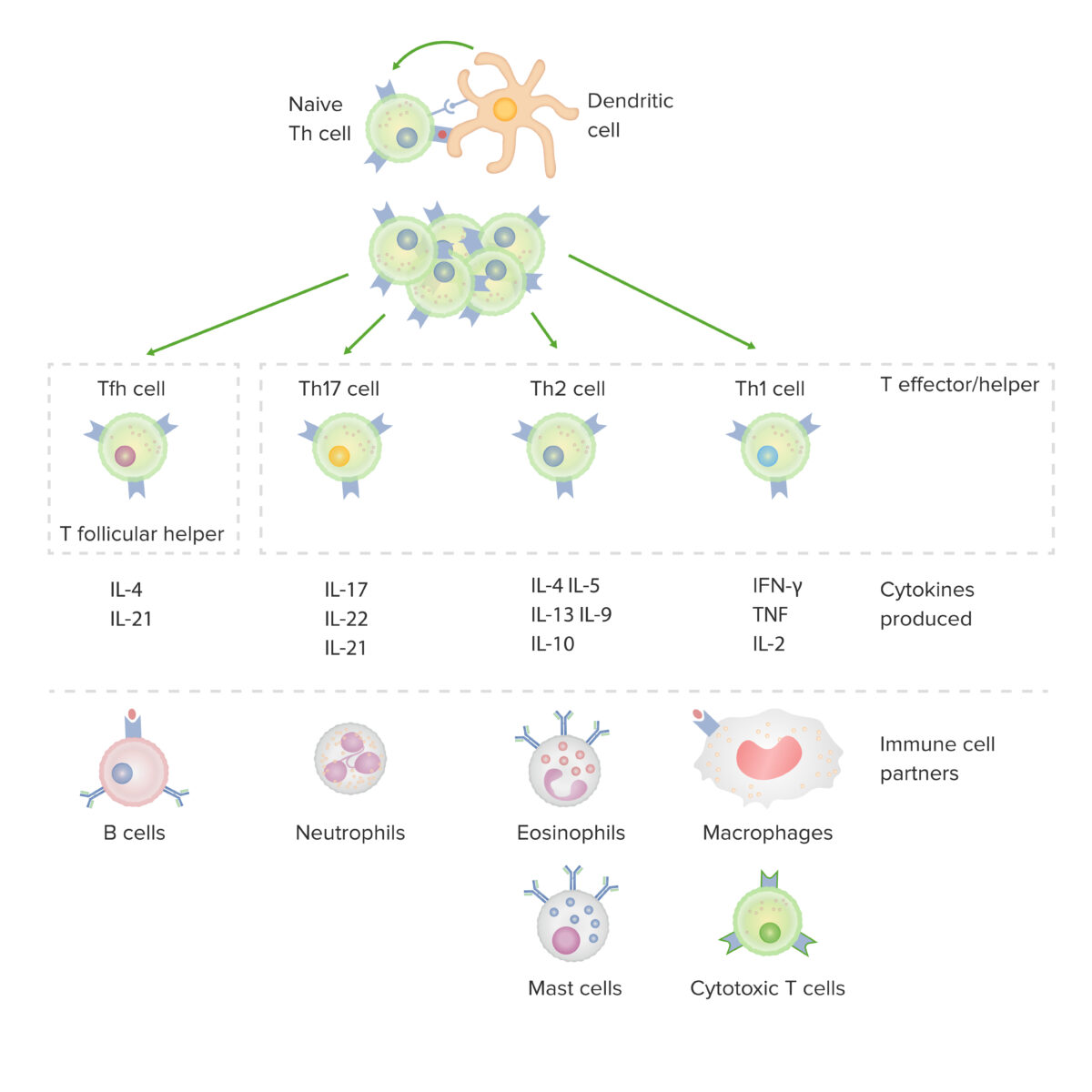
Subsets of CD4+ T cells, including the cytokines produced and associated immune cell partners
IFN: interferon
TNF: tumor necrosis factor
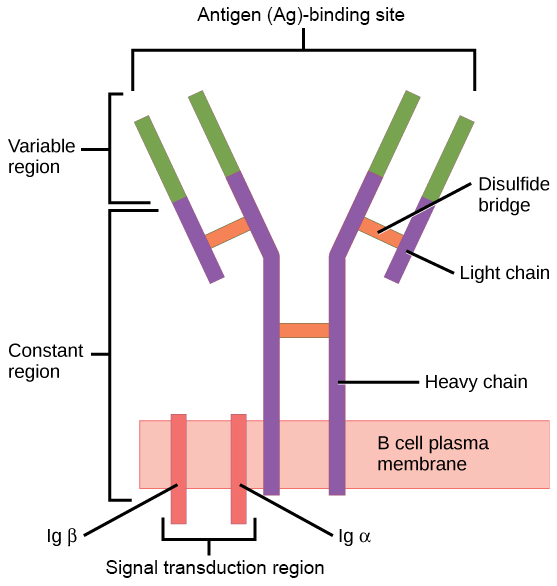
B cell receptor (BCR):
Consists of the Ig molecule and signaling molecule.
The membrane-bound Ig is anchored to the cell surface. The
Ig contains 2 identical heavy chains and 2 identical light chains, linked by a disulfide bridge.
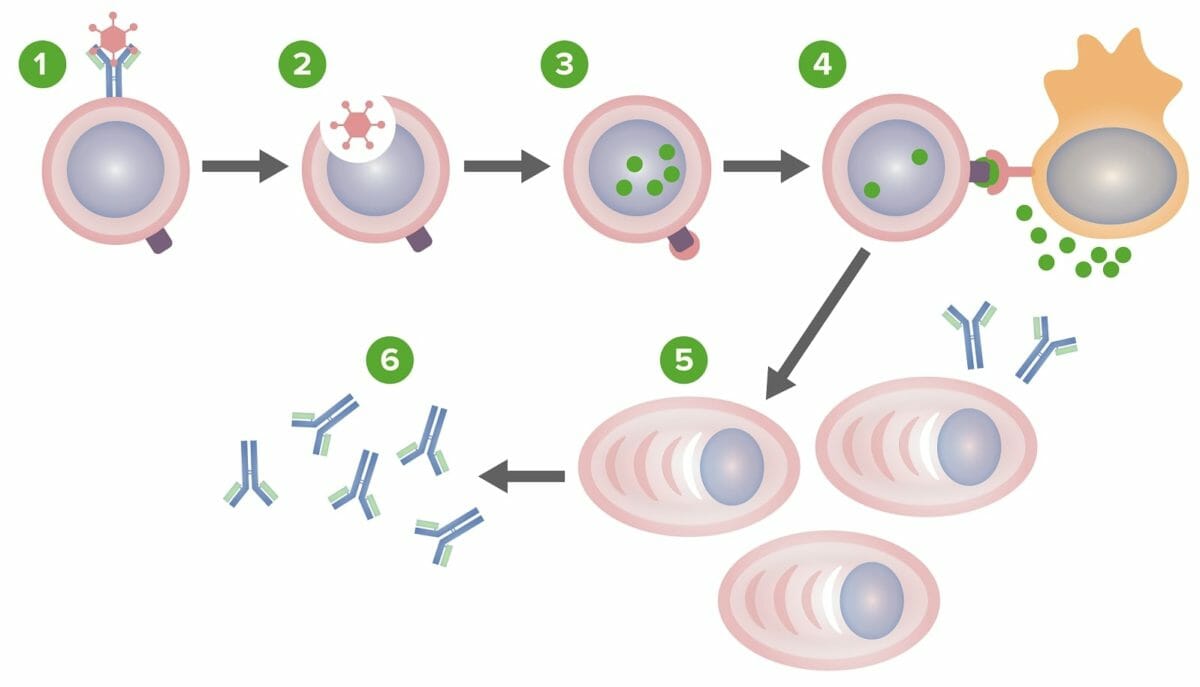
B cell activation in the humoral immune response to produce antibodies:
1) The B cell is triggered when encountered by a matching antigen (Ag).
2) The B cell engulfs and digests the Ag.
3) Ag fragments bound to the unique MHC molecule are displayed.
4) The combination of Ag and MHC attracts the help of a mature, matching T cell.
5) Cytokines secreted by the T cell help the B cell to multiply and mature into antibody-producing plasma cells.
6) Released into the blood, the antibody locks onto a matching Ag. The Ag-antibody complex is cleared by either the complement cascade or the liver and spleen.
A memory Memory Complex mental function having four distinct phases: (1) memorizing or learning, (2) retention, (3) recall, and (4) recognition. Clinically, it is usually subdivided into immediate, recent, and remote memory. Psychiatric Assessment cell is an Ag-specific B or T lymphocyte that produces a strong immune response after re-exposure to the same pathogen. Both memory Memory Complex mental function having four distinct phases: (1) memorizing or learning, (2) retention, (3) recall, and (4) recognition. Clinically, it is usually subdivided into immediate, recent, and remote memory. Psychiatric Assessment B and T cells T cells Lymphocytes responsible for cell-mediated immunity. Two types have been identified – cytotoxic (t-lymphocytes, cytotoxic) and helper T-lymphocytes (t-lymphocytes, helper-inducer). They are formed when lymphocytes circulate through the thymus gland and differentiate to thymocytes. When exposed to an antigen, they divide rapidly and produce large numbers of new T cells sensitized to that antigen. T cells: Types and Functions express the surface marker CD27.
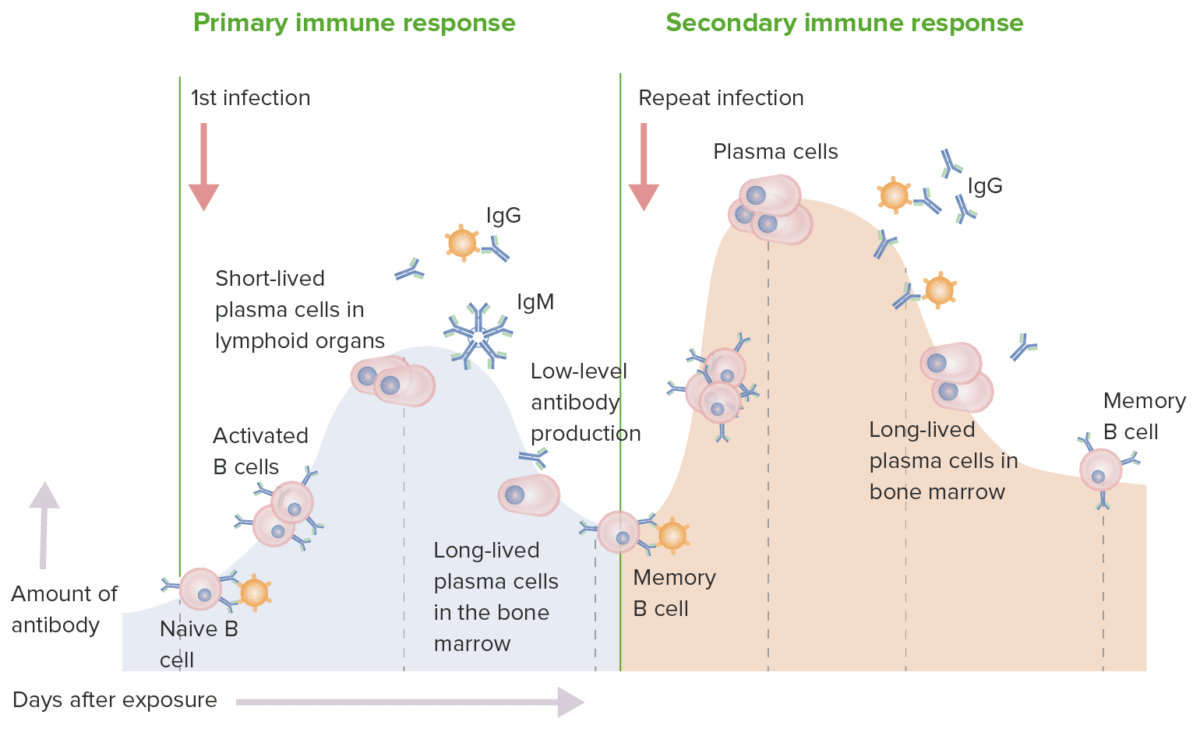
Primary and secondary immune responses:
In a primary immune response, naive B cells are stimulated by antigen (Ag). B cell activation and then differentiation into antibody-secreting cells occur. The antibodies are specific for the eliciting Ag. Then IgM production is followed by IgG. While there is an immune response, the production is low level. In the secondary immune response, the same Ag stimulates memory B cells, leading to the production of greater quantities of specific antibodies that are produced in the primary response. The production and release of IgG also occurs earlier.